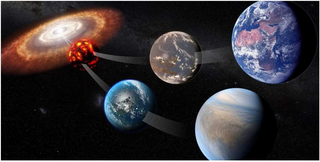
Carl Edward Sagan was an American astronomer, planetary scientist and science communicator. His best known scientific contribution is his research on the possibility of extraterrestrial life, including experimental demonstration of the production of amino acids from basic chemicals by exposure to light. He assembled the first physical messages sent into space, the Pioneer plaque and the Voyager Golden Record, which were universal messages that could potentially be understood by any extraterrestrial intelligence that might find them. He argued in favor of the hypothesis, which has since been accepted, that the high surface temperatures of Venus are the result of the greenhouse effect.

The Drake equation is a probabilistic argument used to estimate the number of active, communicative extraterrestrial civilizations in the Milky Way Galaxy.
Extraterrestrial life, or alien life, is life that originates from another world rather than on Earth. No extraterrestrial life has yet been scientifically conclusively detected. Such life might range from simple forms such as prokaryotes to intelligent beings, possibly bringing forth civilizations that might be far more, or far less, advanced than humans. The Drake equation speculates about the existence of sapient life elsewhere in the universe. The science of extraterrestrial life is known as astrobiology.

The Fermi paradox is the discrepancy between the lack of conclusive evidence of advanced extraterrestrial life and the apparently high likelihood of its existence. Those affirming the paradox generally conclude that if the conditions required for life to arise from non-living matter are as permissive as the available evidence on Earth indicates, then extraterrestrial life would be sufficiently common such that it would be implausible for it not to have been detected yet.

The Kardashev scale is a method of measuring a civilization's level of technological advancement based on the amount of energy it is capable of harnessing and using. The measure was proposed by Soviet astronomer Nikolai Kardashev (1932–2019) in 1964 and was named after him.
Extraterrestrial intelligence (ETI) refers to hypothetical intelligent extraterrestrial life. No such life has ever been verifiably observed to exist. The question of whether other inhabited worlds might exist has been debated since ancient times. The modern form of the concept emerged when the Copernican Revolution demonstrated that the Earth was a planet revolving around the Sun, and other planets were, conversely, other worlds. The question of whether other inhabited planets or moons exist was a natural consequence of this new understanding. It has become one of the most speculative questions in science and is a central theme of science fiction and popular culture.

The Gods Themselves is a 1972 science fiction novel written by Isaac Asimov, and his first original work in the science fiction genre in fifteen years. It won the Nebula Award for Best Novel in 1972, and the Hugo Award for Best Novel in 1973.
The mediocrity principle is the philosophical notion that "if an item is drawn at random from one of several sets or categories, it's more likely to come from the most numerous category than from any one of the less numerous categories". The principle has been taken to suggest that there is nothing very unusual about the evolution of the Solar System, Earth's history, the evolution of biological complexity, human evolution, or any one nation. It is a heuristic in the vein of the Copernican principle, and is sometimes used as a philosophical statement about the place of humanity. The idea is to assume mediocrity, rather than starting with the assumption that a phenomenon is special, privileged, exceptional, or even superior.

The Stars, Like Dust is a 1951 science fiction mystery book by American writer Isaac Asimov.
The concept of self-replicating spacecraft, as envisioned by mathematician John von Neumann, has been described by futurists and has been discussed across a wide breadth of hard science fiction novels and stories. Self-replicating probes are sometimes referred to as von Neumann probes. Self-replicating spacecraft would in some ways either mimic or echo the features of living organisms or viruses.

The City and the Stars is a science fiction novel by British writer Arthur C. Clarke, published in 1956. This novel is a complete rewrite of Clarke's earlier Against the Fall of Night, his first novel, which had been published in Startling Stories magazine in 1948 after being rejected by the editor of Astounding Science-Fiction, according to the author.

In planetary astronomy and astrobiology, the Rare Earth hypothesis argues that the origin of life and the evolution of biological complexity, such as sexually reproducing, multicellular organisms on Earth, and subsequently human intelligence, required an improbable combination of astrophysical and geological events and circumstances. According to the hypothesis, complex extraterrestrial life is an improbable phenomenon and likely to be rare throughout the universe as a whole. The term "Rare Earth" originates from Rare Earth: Why Complex Life Is Uncommon in the Universe (2000), a book by Peter Ward, a geologist and paleontologist, and Donald E. Brownlee, an astronomer and astrobiologist, both faculty members at the University of Washington.
The zoo hypothesis speculates on the assumed behavior and existence of technologically advanced extraterrestrial life and the reasons they refrain from contacting Earth. It is one of many theoretical explanations for the Fermi paradox. The hypothesis states that extraterrestrial life intentionally avoids communication with Earth to allow for natural evolution and sociocultural development, and avoiding interplanetary contamination, similar to people observing animals at a zoo. The hypothesis seeks to explain the apparent absence of extraterrestrial life despite its generally accepted plausibility and hence the reasonable expectation of its existence.
The Great Filter is the idea that, in the development of life from the earliest stages of abiogenesis to reaching the highest levels of development on the Kardashev scale, there is a barrier to development that makes detectable extraterrestrial life exceedingly rare. The Great Filter is one possible resolution of the Fermi paradox.

An Earth analog, also called an Earth analogue, Earth twin, or second Earth, is a planet or moon with environmental conditions similar to those found on Earth. The term Earth-like planet is also used, but this term may refer to any terrestrial planet.

The Voyager Golden Record contains 116 images and a variety of sounds. The items for the record, which is carried on both the Voyager 1 and Voyager 2 spacecraft, were selected for NASA by a committee chaired by Carl Sagan of Cornell University. Included are natural sounds, musical selections from different cultures and eras, spoken greetings in 59 languages, human sounds like footsteps and laughter, and printed messages from President Jimmy Carter and U.N. Secretary-General Kurt Waldheim.
The cultural impact of extraterrestrial contact is the corpus of changes to terrestrial science, technology, religion, politics, and ecosystems resulting from contact with an extraterrestrial civilization. This concept is closely related to the search for extraterrestrial intelligence (SETI), which attempts to locate intelligent life as opposed to analyzing the implications of contact with that life.

In astrobiology and planetary astrophysics, the galactic habitable zone is the region of a galaxy in which life is most likely to develop. The concept of a galactic habitable zone analyzes various factors, such as metallicity and the rate and density of major catastrophes such as supernovae, and uses these to calculate which regions of a galaxy are more likely to form terrestrial planets, initially develop simple life, and provide a suitable environment for this life to evolve and advance. According to research published in August 2015, very large galaxies may favor the birth and development of habitable planets more than smaller galaxies such as the Milky Way. In the case of the Milky Way, its galactic habitable zone is commonly believed to be an annulus with an outer radius of about 10 kiloparsecs (33,000 ly) and an inner radius close to the Galactic Center.

The theorized habitability of red dwarf systems is determined by a large number of factors. Modern evidence suggests that planets in red dwarf systems are unlikely to be habitable, due to their low stellar flux, high probability of tidal locking, likely lack of magnetospheres and atmospheres, and the high stellar variation such planets would experience. However, the sheer number and longevity of red dwarfs could provide ample opportunity to realize any small possibility of habitability.
The Hart–Tipler conjecture is the idea that an absence of detectable Von Neumann probes is contrapositive evidence that no intelligent life exists outside of the Solar System. This idea was first proposed in opposition to the Drake equation in a 1975 paper by Michael H. Hart titled "Explanation for the Absence of Extraterrestrials on Earth". Assuming that the probes traveled at 1/10 the speed of light and that no time was lost in building new ships upon arriving at the destination, Hart surmised that a wave of Von Neumann probes could cross the galaxy in approximately 650,000 years, a comparatively minimal span of time relative to the estimated age of the universe at 13.7 billion years. Hart’s argument was extended by cosmologist Frank Tipler in his 1981 paper entitled "Extraterrestrial intelligent beings do not exist".












